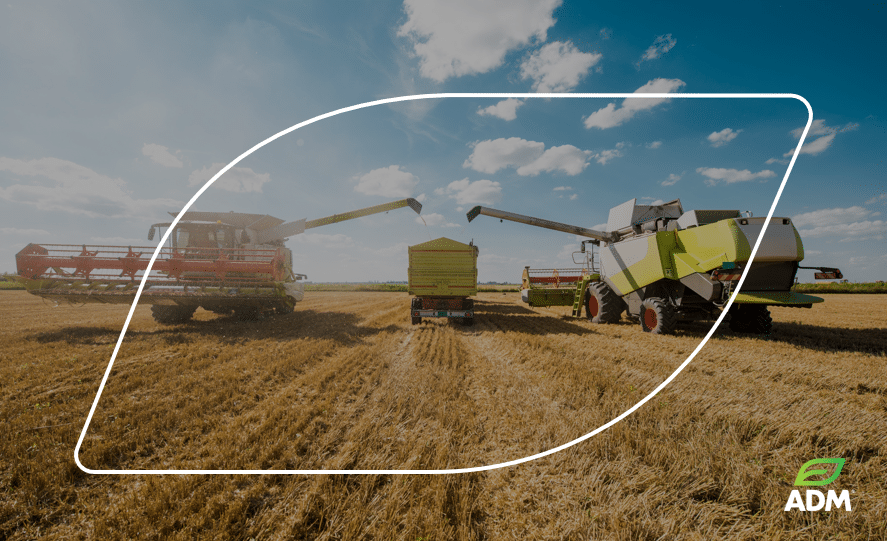WELCOME TO ADM AGRICULTURE WEEKLY MARKET REPORT
Wheat
- The US market has fallen just over $8/t during the past week as hawkish comments from the FED suggest that interest rates are likely to head higher and for longer than expected, raising concerns over future demand for US commodities.
- USDA’s latest world supply and demand report released on Wednesday reported unchanged US numbers, although global stocks were trimmed from the February forecasts mainly because of an annual revision to Chinese data. (Excluding China, global stocks increased 2.87 million tonnes over the month.)
- USDA slashed Argentine maize production by 7 million tonnes to 40 million tonnes, although higher production in India, plus a few other minor hikes and lower global use, lifted global ending stocks by 1.18 million tonnes.
- Officials from the various parties have started to discuss the Black Sea grain export deal, with most trade expectations seeing the deal being extended for a minimum of 120 days.
- ABARES raised its estimate for the 2022/23 Australian wheat crop to 39.2 million tonnes from 36.6 million tonnes. It has reduced its estimate for 2023/24 to 28.2 million tonnes due to a shift to warmer, drier conditions if El Nino develops as expected.
- Canadian farmers are poised to sow an extra 7.3% to wheat (excluding durum) in 2023, as farmers shift away from oats and pulse crops.
- Ukraine’s agriculture ministry now puts the area sown to winter crops at 4.1 million hectares and the wheat crop between 16-18 million tonnes. The ministry added it saw no need to limit wheat exports in the 2023/24 marketing season.
- SovEcon agency has slightly lowered Russia’s wheat export figure for 2022/23 to 44.1 million tonnes, due to a slowdown in February exports due to adverse weather conditions.
- Ukraine and Poland have agreed to ease the transit of Ukrainian grain and oilseed exports via Poland, with new procedures taking effect this week to help speed up checks.
- French wheat futures (May23) have fallen €4.75/t over the week due to the global bearish sentiment and aggressive offers from the Black Sea region.
- UK prices for the same month have followed, slipping £5/t despite a weaker pound and a marked slowdown in ex-farm sales.
Malting Barley
- Malting barley prices have pulled back slightly on the week, on weaker futures and much-needed rainfall arriving over key growing areas in Northern Europe, which will benefit the developing crop.
- Demand remains low as consumers are well covered against requirements, and we have not seen additional pricing from the brewing sector. UK spring barley plantings continue to progress, but farmer selling remains limited for a further week.
Feed Barley
- Feed barley markets have seen no activity over the last week. Prices for both old and new crop are coming under pressure; physical demand is nowhere to be found and feed barley is being pushed lower by falling wheat prices.
Rapeseed
- The bullish sentiment for the US soy complex has continued, with consecutive sessions of gains for soybeans across all contracts at the start of the week after the USDA report, volatility in the US dollar, and question marks around global supply and demand.
- The key soy story of the week is extreme weather conditions in Argentina, where key production areas have experienced hot temperatures and dry conditions that look to persist throughout the first half of March.
- This will weigh on Argentina’s production, with official production forecasts for maize and soy set to fall. Brazil and the US could well benefit, with record production of soybeans potentially filling the void.
- The weather looks to have taken its toll in South America with Wednesday’s USDA report trimming Argentina’s production figures from 36.8 million tonnes to 33 million and left Brazil is unchanged at 153 million tonnes. Export estimates for both Brazil and the US were increased due to the shortfall.
- One point that could potentially derail this rally for soy in the long term are question marks around China’s consumption of oilseeds. China announced a rather unambitious 2023 GDP target of 5%, its lowest in decades, with comments from Beijing focusing on economic stability and self-sufficiency. As a key commodity consuming nation this was not positive news and did cause prices to dip, although this looks to be a more long-term development as commodity imports continue this year.
- China is the world’s biggest oilseed buyer and has stepped up purchases recently with imports up 16% on the year. Although soybean imports rose, other commodity imports are lagging. Combined with the meager GDP target, this does call into question China’s long-term pattern of consumption.
- European oilseeds fared less well compared to soybeans, with prices on the May down over €30 from last week. Losses extended rapidly towards the end of the week and, with a key downside target of €520 broken, it looks like losses will be sustained for now. Prices are being weighed down by a stronger euro, a fall in the price of alternative oils and a decrease in energy markets across the Continent.
- UK prices remain tied to our European counterparts. Whilst a drop in sterling offered some support, it was not enough to offset the losses in Matif rapeseed values, which look set to continue.
Oats
- Global old crop grain prices continue to fall due to cheap offers from Russia weighing on the market, which has fed through to oat values.
- Consumers in Europe continue to be well covered. Some suggest there is some May-Aug still to buy, but with bearish trend continuing consumers are not looking to pull the trigger just yet.
- Reports of higher-than-normal extraction rates is one of the reasons being cited for the lack of demand from the milling oat sector and with surplus still to sell, long holders in Scandinavia and the UK may see stocks carried over into new crop.
- UK exports to the EU continue at a record pace with 133,000t exported in the year to date. This could tighten the balance sheet as towards the end of the season.
- The overall balance sheet in the UK is looking tighter than it was, but the key figure will be the on-farm feed usage as this will have the biggest impact in determining carryout stock.
Pulses
- There has been little movement from last week’s report. Feed peas are trading sidewards, and we expect further demand to come into the market during the next quarter as consumers are currently covered.
- Human consumption green pea demand is ramping up for both old and new crop. We are keen buyers of any old crop parcels as well as looking to book up further area on the new crop. With buybacks still available and the option to drill peas into April, green peas are a great break prior to the next wheat crop. Prices are historically high for large blues, so please contact your farm buyer if you are interested.
Seed
- Spring seed is largely now all on farm. For any top-ups or last-minute cropping decisions we do still have some spring wheat and barley stocks available for quick delivery.
- Peas are an excellent option if you are still looking for an alternative break crop, we have buybacks available and seed on the floor ready to be delivered.
- ADM has a great game maize blend to offer that is perfect for birds to feed from and all-season cover. We also have a range of countryside stewardship mixes available ranging from AB1 to AB16.
- As well as this we have some spring-sown cover crops that can benefit the land in multiple ways and help to prepare the soils for the following crop. Enquire with your farm trader for more information.
- Looking ahead to the autumn, all newly recommended varieties have extremely limited availability, otherwise, we currently have good stocks across our portfolio.
Fertiliser
- Sole UK ammonium nitrate manufacturer CF issued updated terms for April delivery this week with small justifiable increases, citing logistical tightness for March.
- Imported AN prices are relatively stable but offers remain limited. Demand in Europe has picked up reducing volumes available for export.
- ANS compounds remain in short supply at present and consideration of what products to use for sulphur requirements for 2023/24 season should be given some consideration. Some ANS products will not be available.
- ADM can offer Nitrasol liquid grades for delivery this spring with spot UAN prices at Rouen having now stabilised.
- Granular and prilled urea remains relatively stable at present, but the threat of potential increases is on the horizon if US dollar strength persists, and AN pricing maintains current premiums.
- ADM can offer granular urea for 2023/24. Product is also available with urease coating 2-NPT for forward purchases to fit in line with new regulations for urea and UAN starting 1 March 2024.
- Phosphate activity is reportedly limited in Europe, but prices remain stable at present. Looking over the month, prices have weakened on average by $50/t on DAP and TSP in some markets.
- Potash markets mirror phosphates, with particular focus on Chinese exports and Brazilian trade. There is minor change to report in European markets.
| £/€ | £/$ | €/$ |
|---|---|---|
| 1.1295 | 1.217 | 1.0775 |
| Feed Barley £ | Wheat £ | Beans £ | Oilseed Rape £ | |
|---|---|---|---|---|
| Mar 2023 | 200-210 | 230-240 | 255-260 | 470-475 |
NB: Prices quoted are indicative only at the time of going to press and subject to location and quality.
“Although ADM Agriculture take steps to ensure the validity of all information contained within the ADM Agriculture Market Report, it makes no warranty as to the accuracy or completeness of such information. ADM Agriculture will have no liability or responsibility for the information or any action or failure to act based upon such information.”
ADM Agriculture cannot accept liability arising from errors or omissions in this publication.
ADM Agriculture trade under AIC contracts which incorporate the arbitration clause.
Terms and Conditions of Purchase.
On every occasion, without exception, grain and pulses will be bought by incorporating by reference the terms & conditions of the AIC No.1 Grain and Peas or Beans contract applicable on the date of the transaction. Also, we will always, and without exception, buy oilseed rape and linseed by incorporating by reference the terms & conditions of the respective terms of the FOSFA 26A and the FOSFA 9A contracts applicable on the date of the transaction. It is a condition of all such transactions that the seller is deemed to know, accept and understand the terms and conditions of each of the above contracts.


